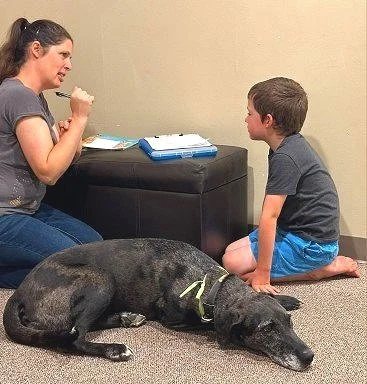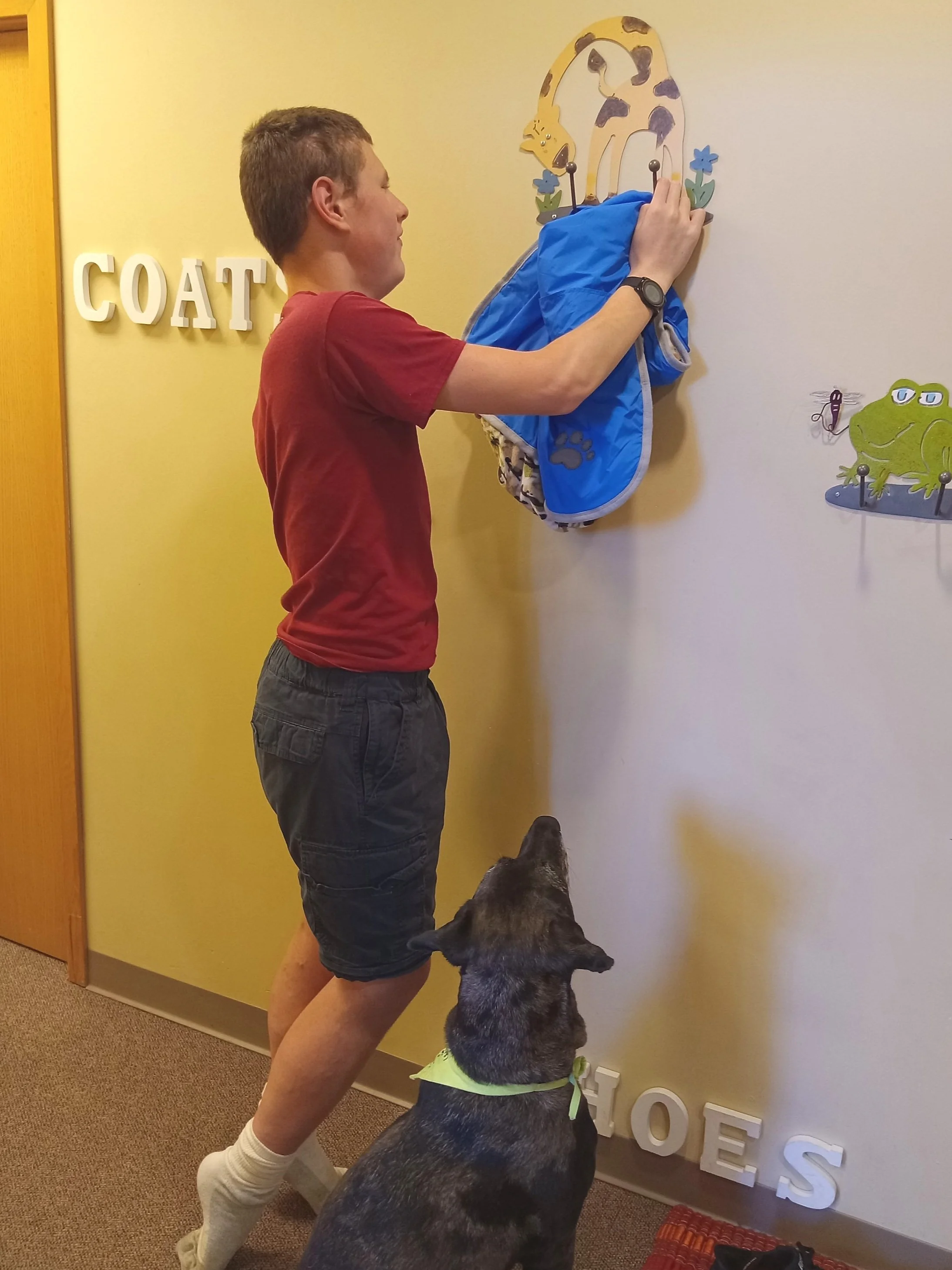A Quandary, a Quibble, and a Query: Musings After Five Years of Animal-Assisted Speech Therapy
“Hmm…Now what do I do?”
The question running through my mind was in response to a new client who was strongly disinterested in every activity I had planned for the session, but later I realized it also applied to the next five years of my career.
I’ve been including therapy dogs—a total of four now—into my private speech, language, and reading therapy clinic for a little over five years, and it has changed me professionally and personally. I’ve learned what does and doesn’t work, how to better read each of my dog’s individual communication styles, and even written a book to help other clinicians.
My skills in animal-assisted therapy have expanded exponentially, and yet…
I still have moments when I’m at a loss.
Here are three recent challenges I’ve faced while working with my amazing speech therapy dogs:
I’ve learned a lot from providing animal-assisted speech therapy over the past five years. Partners like therapy dog extraordinaire Delta Dawn have been my best teachers, but I know I still have much more to learn.
If you click a link it’s likely an affiliate link and I will earn a small commission if you purchase. It does not cost you anything extra. If I don’t use and love a product, you won’t find it here!
A Quandary: Avoiding over-reliance on the therapy dog
Animal-assisted interventions have become so second-nature to me that it’s easy to over-rely on my dogs to help me establish connections with clients.
The vast majority of kids and families on my caseload beam when entering the office to greet Delta or Sky. If an activity isn’t going well I can often redirect unwanted behaviors by:
· asking the child to help me get treats or fill the dog’s water bowl to interrupt escalating anxieties
· switching my models and prompts to apply to what the dog is doing instead of sticking with more traditional therapy materials, such as practicing verbs while asking the dog to perform tricks instead of with a fishing game of verb pictures
· suggesting the child take the role of teacher for the dog, such as “reminding” the dog where we hang up our coats for a transition or “reading” therapy materials to the dog
· allowing the child to team up with the dog against me, such as taking turns in a board game on behalf of the dog or hiding materials so I have to find them while the dog follows us around the office
· capitalizing on the dogs’ ability to help with sensory regulation
Occasionally though I have clients who just don’t see the therapy dogs as anything more than another object in the office.
The seven-year-old child that left me wondering, “now what?” was one of those. He wasn’t afraid of Delta or overstimulated by her presence, but his mom had accurately said on intake he just doesn’t have any interest in animals and is always on his own agenda.
I’d struggled for several sessions to bond with him over his love of robots and by playing together on sensory equipment, where his primary mission seemed to be “crushing” and “destroying” me in mock battles of his own invention with ever-changing rules I could never quite grasp. He was adept at dodging any attempt to start a more structured activity or changing the topic any time I tried to model the sounds or syntax he needed to add to his speech.
And since none of my “tricks” of including Delta elicited even the slightest interest, I was stuck trying to remember how I would handle such a situation prior to animal-assisted therapy.
In the end, it took longer than I would have liked to find ways to engage this little boy in goal-directed communication activities, and I still don’t get as many repetitions as I would like. After discussion with his mom I’ve let go of trying to redirect his fixation on violence and lean in to being repeatedly “defeated” if it keeps him interacting. And I hope over time I’ll be able to share the lead a bit more in deciding our activities for the day.
Of course, having a therapy dog to pet or take for a quick walk after these more challenging sessions allows me a few moments to regroup, so their presence is still appreciated even if it’s not the client doing the appreciating.
Therapy dog Delta provides support as a teen with complex needs practices hanging up coats to transition into an animal-assisted speech therapy session.
I often find clients will perform tasks for the dogs that they might otherwise avoid or resist if I ask directly.
A Quibble: Why isn’t my therapy dog perfect?
Yes, I know that sounds like a silly question.
However, I sometimes find myself frustrated when Delta or Sky ignore my direction. Sometimes when I am struggling to engage a child they choose to go lie on the bed away from the action, other times when I need a calming influence they feed off the child’s energy instead.
In those moments I become frustrated. I’m human.
When I take time to reflect I know that in the majority of sessions my therapy dogs offer behaviors that are truly helpful, often without prompting. Delta frequently comes and rests her head on a child that is showing some anxiety. In the same situation, Sky will give a sassy little bark or bring her toy for a toss. Both uniquely contribute to redirecting a child and allowing me a moment to reconsider my approach to better suit the child’s learning abilities in that moment.
So how do I keep that knowledge forefront and let go of the less-than-perfect moments when I myself am feeling pressure in a challenging session? I’m still working to answer this question.
Therapy dog Sky sometimes feeds off children’s energy when I would prefer she model calm behavior in an animal-assisted speech therapy session.
A Query: What criteria will help me choose my next speech therapy dog candidate?
Ok, ok...it’s still off in the future! But since I know I want to continue to provide animal-assisted therapy throughout my career, how will I choose my next therapy dog candidate?
Since Delta doesn’t get along well with other adult dogs but happily “raised” our pup Bodhi (and her own litter before we adopted her), I will likely be purchasing from a breeder.
I love the idea of “Puppy Culture”, where breeders complete specific exercises at specific times with developing pups to increase their stress tolerance, and of course early positive socialization is helpful.
Yet last time I was looking for a pup I couldn’t find anyone in my area reporting this practice.
I love the idea of temperament testing a puppy through exercises like holding them on their back to see how long they struggle and how quickly they recover from surprises like an umbrella opening.
Yet I did that with Johnny Utah as a pup and he passed with flying colors on the day I came to pick him out, but once home I found his response varied from moment to moment. (Johnny Utah went on to be a fantastic therapy dog, but only after his incredible high-energy lessened a bit around age 7—see What My Ever-Wiggling Brittany Taught Me About Animal-Assisted Speech Therapy ). And from what I can find online these “tests” have been largely debunked.
Could their popularity derive from confirmation bias? Well-bred puppies with breeders who care enough to try this type of behavior testing find their puppies pass, so they come to believe it is the test results that are important and not the solid genetics and early handling? Perhaps. Or perhaps the premise of temperament testing puppies is solid but sensitive to developmental periods that may not always be obvious when purchasing a puppy.
However, if I decide to get another rescue like Delta, how do I know what the dog will act like outside of the shelter or foster home? A local shelter claims to behavior test their animals, yet I’ve known several people who’ve adopted a dog there that behaved very differently at home than was reported.
All behavior testing is not the same and requires a highly experienced behavior expert to perform and interpret accurately.
Furthermore, a shelter is a high-stress environment. I’d hate to overlook a wonderful therapy dog candidate because they were being pushed past their limits of tolerance in the sensory and emotional overwhelm of a large group kennel with a rotation of caregivers.
Sky has settled terrifically into her role as a speech therapy dog despite lacking much early socialization.
Her temperament is fortunately inherently geared towards an affiliative nature, but assessing this when choosing a puppy or rescue dog can be challenging.
Paralysis by analysis is a real thing!
If you have experience with behavior testing with pups or adults and have thoughts on this topic, I’d love to hear from you. Contact me here or DM on Instagram @Speech_Dogs with ideas.
(If you’re currently considering therapy dog selection, check out this great YouTube video on the Dr. Dog Lady channel)
So, as I work to solve these challenges and more, what will the next five years bring?
I know I intend to continue providing animal-assisted therapy, further improving both my speech therapy skills and therapy dog handling skills in ways I may not yet be able to imagine. And I know there will be more quandaries, more quibbles, and more queries as I do.
I guess that’s the just how it goes for an animal-assisted speech language pathologist.
If you’re interested in starting a therapy dog journey but aren’t sure where to start, check out Paws for Progress: Integrating Animal-Assisted Interventions into Your Speech-Language Pathology Practice available now!
And click over to the Speech Dogs YouTube channel for videos on specific therapy dog topics.
May your days be filled with puppy wiggles and children’s giggles,
Sharlet
Update: I have found one activity that the boy from the opening section enjoys playing with my therapy dogs—trying to “trick” them by hiding treats in a Nina Ottoson dog puzzle. He has also shown some interest in animal-related engagement, primarily looking at books of “disgusting” or “creepy” animals, such as this great photo book.





